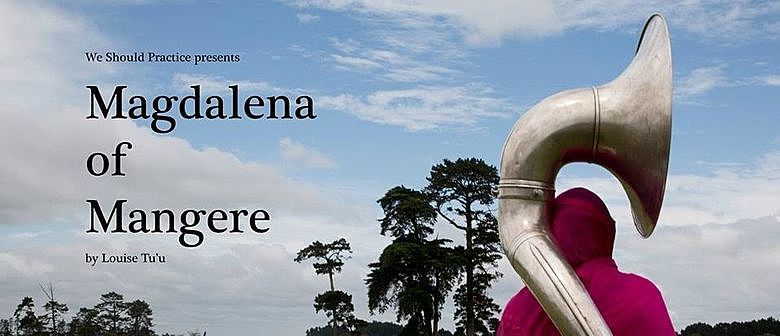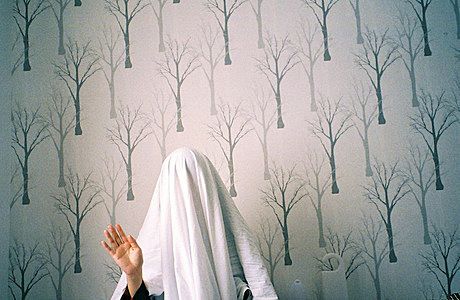A Gateway: A Review of Magdalena of Mangere
A show that's a glimpse into a suburb that is known more for its role as a gateway to the country than it is for the people who occupy it. Madeleine de Young finds a messy warmth in Magdalena of Māngere.
A show that's a glimpse into a suburb that is known more for its role as a gateway to the country than it is for the people who occupy it. Madeleine de Young finds a messy warmth in Magdalena of Māngere.
Less than five minutes from Auckland International Airport lies Māngere township, a community that is largely brown, young and committed to faith. Beyond the township, Māngere is one of the largest suburbs in Auckland, it’s home to the largest Muslim school in Auckland and the pies are delicious.
Magdalena of Māngere seeks to give identity to this place and it gives this identity through a series of fractured vignettes. Andrew Malele plays an exuberant gym instructor while Mustaq Missouri shepherds a flock of roaming white balloons. In between these scenes, writer and director Louise Tu’u is the CYFs kid reunited with their mother as an adult, the WINZ worker who just wants to keep her head down and make a living and herself - the community advocate who wants her people to vote.
In Māngere, the median age is 28.3 years old - the median age for a New Zealand as a whole is 38. Of those aged 18 - 24 years old who were enrolled to vote at the last election, 59% actually voted - 3,648 people. Youth voter turnout is a problem for the whole country but when your population is largely young and they don’t vote, your ability to voice issues important to your population is substantially diminished.
Tu’u invites a representative of the Electoral Commission on stage during each show to help address this. By demystifying voting, there is hope that more people in the community will enroll. An enrollment station is even set up in the foyer to help assist this, but in some ways it feels like this element has been shoehorned into the performance, theatrically rather than thematically. However, Tu’u has employed a number of creatives to assist with the production who add swathes of theatricality to the piece in a visual and aural sense, which contrasts starkly with the raw storytelling on stage.
Peau Halapua contributes a stunning score, performed live on the violin with the accompaniment of Linda Filimoehala on euphonium. All of the performers are decked out in full white, with white props that creates a sense of formality for the audience that is not strictly mirrored in the performance. This clash of format and story serve Tu’u’s purpose of presenting a picture of South Auckland Polynesia that isn’t a dawn raids story or a welcoming 'intro to brown', but is a portrait of a people in all their simultaneous moments of complexity and subtlety.
This is demonstrated throughout the show in scenes which reference state organisations like CYFs, WINZ and Housing New Zealand as natural aspects of life. Instead of the usual narrative of protest, justification and reform, Tu’u places these organisations within mundane day to day situations.
For example, in the CYFs scene, we see a mother and daughter meet and eat pies. While the shadow of a CYFs upbringing hovers in the small talk - Tu’u doesn’t seek an emotional revelation about the life of someone in state care in this show. Instead the pies take precedence with five minutes of crunching, mouth filled nods and pastry flung from smacked lips. All at once the scene is complicated, boring and riveting as it is literally five minutes of watching two people eat pies and nod.
Similarly, in the role of a WINZ worker, Tu’u bemoans the protesters who stand outside the office in an attempt to improve her lot. When all the names on the list of clients for that day are friends or family; having a job, keeping her head down and earning money is more desirable than kicking up a stink. In these scenes, Tu’u puts the people of Māngere front and center while the politics comes second, because for this suburb what may be complicated in a political conversation is the backdrop to their lives. It’s a novel contrast to see big issues take a backseat to the simple act of chowing down on a pie. But through Tu’u’s staging and the musical accompaniment, pie eating becomes a fascination.
Magdalena of Māngere is full of these small moments wrapped in big theatrics that create an intimate relationship with the audience. On many levels it shouldn’t work - the story is too fractured, the juxtaposition of design and performance too wide and the space too big. But the overwhelming sense that I took home with me was one of warmth.
Magdalena of Mangere runs at
Mangere Arts Centre
from Wednesday 29 March to Saturday 1 April
For tickets to and more information about Magdalena of Mangere, go here.

